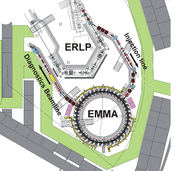
EMMA (accelerator)
Encyclopedia

Daresbury Laboratory
Daresbury Laboratory is a scientific research laboratory near Daresbury in Cheshire, England, which began operations in 1962 and was officially opened on 16 June 1967 as the Daresbury Nuclear Physics Laboratory by the then Prime Minister of United Kingdom, Harold Wilson...
in the UK to build a linear non-scaling FFAG to accelerate electron
Electron
The electron is a subatomic particle with a negative elementary electric charge. It has no known components or substructure; in other words, it is generally thought to be an elementary particle. An electron has a mass that is approximately 1/1836 that of the proton...
s from 10 to 20 MeV
MEV
MeV and meV are multiples and submultiples of the electron volt unit referring to 1,000,000 eV and 0.001 eV, respectively.Mev or MEV may refer to:In entertainment:* Musica Elettronica Viva, an Italian musical group...
. A FFAG (Fixed Field Alternating Gradient) is a type of accelerator in which the magnetic field in the bending magnets is constant during acceleration. This means the particle beam will move radially outwards as its momentum increases.
A linear non-scaling FFAG is one in which a quantity known as the betatron
Betatron
A betatron is a cyclotron developed by Donald Kerst at the University of Illinois in 1940 to accelerate electrons, but the concepts ultimately originate from Rolf Widerøe and previous development occurred in Germany through Max Steenbeck in the 1930s. The betatron is essentially a transformer with...
tune is allowed to vary unchecked. In a conventional synchrotron
Synchrotron
A synchrotron is a particular type of cyclic particle accelerator in which the magnetic field and the electric field are carefully synchronised with the travelling particle beam. The proton synchrotron was originally conceived by Sir Marcus Oliphant...
such a variation would result in loss of the beam. However, in EMMA the beam will cross these resonances so rapidly that their effect should not be seen. EMMA will use the ALICE accelerator as a source of electrons and will be situated in the same laboratory at STFC's Daresbury site.
EMMA is a proof-of-principle machine; the experience gained in building this machine will be useful for future muon
Muon
The muon |mu]] used to represent it) is an elementary particle similar to the electron, with a unitary negative electric charge and a spin of ½. Together with the electron, the tau, and the three neutrinos, it is classified as a lepton...
accelerators (which are used in neutrino
Neutrino
A neutrino is an electrically neutral, weakly interacting elementary subatomic particle with a half-integer spin, chirality and a disputed but small non-zero mass. It is able to pass through ordinary matter almost unaffected...
factories), and also for proton
Proton
The proton is a subatomic particle with the symbol or and a positive electric charge of 1 elementary charge. One or more protons are present in the nucleus of each atom, along with neutrons. The number of protons in each atom is its atomic number....
and carbon
Carbon
Carbon is the chemical element with symbol C and atomic number 6. As a member of group 14 on the periodic table, it is nonmetallic and tetravalent—making four electrons available to form covalent chemical bonds...
ion particle accelerator
Particle accelerator
A particle accelerator is a device that uses electromagnetic fields to propel charged particles to high speeds and to contain them in well-defined beams. An ordinary CRT television set is a simple form of accelerator. There are two basic types: electrostatic and oscillating field accelerators.In...
s, which have applications for cancer
Cancer
Cancer , known medically as a malignant neoplasm, is a large group of different diseases, all involving unregulated cell growth. In cancer, cells divide and grow uncontrollably, forming malignant tumors, and invade nearby parts of the body. The cancer may also spread to more distant parts of the...
therapy.
As a non-scaling FFAG, EMMA will also be a good candidate for use in an Accelerator Driven Subcritical Reactor
Subcritical reactor
A subcritical reactor is a nuclear fission reactor that produces fission without achieving criticality. Instead of a sustaining chain reaction, a subcritical reactor uses additional neutrons from an outside source...
system in which a non critical fission core is driven to criticality by a small accelerator. Future electrical power generation could be influenced heavily by the use power stations consisting of a sub-critical core containing a material such as thorium
Thorium
Thorium is a natural radioactive chemical element with the symbol Th and atomic number 90. It was discovered in 1828 and named after Thor, the Norse god of thunder....
, and a small accelerator capable of providing extra neutrons via a spallation target.
EMMA is funded by the BASROC consortium, under the CONFORM umbrella. Commissioning of EMMA began in June 2010 when the beam was injected and sent around part of the ring. Full ring commissioning is due to commence in August 2010.

